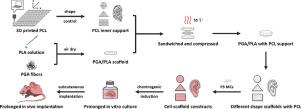Applied Materials Today ( IF 8.3 ) Pub Date : 2020-06-23 , DOI: 10.1016/j.apmt.2020.100724 Zongqi Yin , Dan Li , Yi Liu , Shaoqing Feng , Lin Yao , Xiaoqin Liang , Chunlei Miao , Yong Xu , Mengjie Hou , Ruhong Zhang , Wenjie Zhang , Wei Liu , Yu Liu , Guangdong Zhou , Yilin Cao

|
Tissue engineering provides a promising approach for auricle reconstruction of microtia. Although the first clinical trial of tissue-engineered ear reconstruction has been performed using in vitro engineered human-ear-shaped cartilage, this approach is not regarded as the clinically available treatment yet, due to individual differences in clinical efficacy. In the present study, the feasibility and in vivo long-term fate of elastic cartilage regenerated with an accurate human-ear shape were explored using polycaprolactone (PCL) inner support strengthened biodegradable scaffold and expanded microtia chondrocytes (MCs) to identify factors that may result in discrepant clinical outcomes. Polyglycolic acid/polylactic acid (PGA/PLA) scaffolds with or without PCL inner support were prepared into different shapes by three-dimensional (3D) printing, hot-compressing, and pre-molding technologies. The expanded MCs were seeded into the scaffolds to evaluate biocompatibility of PCL inner support and its influence on cartilage regeneration, tissue integration, mechanical strength, and shape maintenance. The results testified that all the cartilages generated by different patients’ cells were highly consistent in both qualitative and quantitative data, indicating high repeatability and stability of cartilage construction technology. PCL inner support manifested a satisfactory biocompatibility and it had no inhibitory effect on cartilage formation, maturation, and tissue integration. After in vivo implantation, the regenerated cartilage without PCL inner support showed the same level of mechanical strength and shape maintenance ability as the PCL strengthened cartilage. Mature and continuous elastic cartilage with an accurate ear shape could be successfully regenerated in vivo with a long-term shape maintenance. All the cells of regenerated cartilage were derived from the implanted MCs, which could survive and maintain their phenotype for a long time. The current study provides reliable evidence, key techniques, and optimized strategies for further clinical applications of in vitro regenerated cartilage with special shapes such as ear, nose, and trachea.
中文翻译:

基于PCL增强的可生物降解支架和扩展的小眼软骨细胞再生具有精确人耳形状的弹性软骨
组织工程学为小耳的耳廓重建提供了一种有前途的方法。尽管已经使用体外工程化的人耳形软骨进行了组织工程化的耳朵重建的首次临床试验,但是由于临床疗效的个体差异,该方法尚未被视为临床可用的治疗方法。在本研究中,可行性和体内使用聚己内酯(PCL)内支撑增强的可生物降解支架和扩增的小眼软骨细胞(MCs)来探索以准确的人耳形状再生的弹性软骨的长期命运,以确定可能导致临床结果差异的因素。通过三维(3D)打印,热压和预成型技术,将具有或不具有PCL内部支撑的聚乙醇酸/聚乳酸(PGA / PLA)支架制成不同的形状。将扩展的MC植入支架中,以评估PCL内支架的生物相容性及其对软骨再生,组织整合,机械强度和形状维持的影响。结果证明,不同患者细胞产生的所有软骨在定性和定量数据上都高度一致,表明软骨构造技术的高重复性和稳定性。PCL内部支持物表现出令人满意的生物相容性,并且对软骨形成,成熟和组织整合没有抑制作用。后在体内植入中,没有PCL内部支撑的再生软骨显示出与PCL增强软骨相同水平的机械强度和形状维持能力。具有长期正确形状的成熟和连续的弹性软骨具有正确的耳朵形状,可以在体内成功再生。再生软骨的所有细胞均来自植入的MC,其可以存活并长期维持其表型。当前的研究为具有特殊形状(如耳,鼻和气管)的体外再生软骨的进一步临床应用提供了可靠的证据,关键技术和优化的策略。


























 京公网安备 11010802027423号
京公网安备 11010802027423号